
eBook - ePub
A Picture History of the Brooklyn Bridge
Mary J. Shapiro
This is a test
Buch teilen
- 122 Seiten
- English
- ePUB (handyfreundlich)
- Über iOS und Android verfügbar
eBook - ePub
A Picture History of the Brooklyn Bridge
Mary J. Shapiro
Angaben zum Buch
Buchvorschau
Inhaltsverzeichnis
Quellenangaben
Über dieses Buch
Profusely illustrated account of the greatest engineering achievement of the 19th century. Rare contemporary photos and engravings, accompanied by extensive, detailed captions, recall construction, human drama, politics, much more. 167 black-and-white illustrations.
Häufig gestellte Fragen
Wie kann ich mein Abo kündigen?
Gehe einfach zum Kontobereich in den Einstellungen und klicke auf „Abo kündigen“ – ganz einfach. Nachdem du gekündigt hast, bleibt deine Mitgliedschaft für den verbleibenden Abozeitraum, den du bereits bezahlt hast, aktiv. Mehr Informationen hier.
(Wie) Kann ich Bücher herunterladen?
Derzeit stehen all unsere auf Mobilgeräte reagierenden ePub-Bücher zum Download über die App zur Verfügung. Die meisten unserer PDFs stehen ebenfalls zum Download bereit; wir arbeiten daran, auch die übrigen PDFs zum Download anzubieten, bei denen dies aktuell noch nicht möglich ist. Weitere Informationen hier.
Welcher Unterschied besteht bei den Preisen zwischen den Aboplänen?
Mit beiden Aboplänen erhältst du vollen Zugang zur Bibliothek und allen Funktionen von Perlego. Die einzigen Unterschiede bestehen im Preis und dem Abozeitraum: Mit dem Jahresabo sparst du auf 12 Monate gerechnet im Vergleich zum Monatsabo rund 30 %.
Was ist Perlego?
Wir sind ein Online-Abodienst für Lehrbücher, bei dem du für weniger als den Preis eines einzelnen Buches pro Monat Zugang zu einer ganzen Online-Bibliothek erhältst. Mit über 1 Million Büchern zu über 1.000 verschiedenen Themen haben wir bestimmt alles, was du brauchst! Weitere Informationen hier.
Unterstützt Perlego Text-zu-Sprache?
Achte auf das Symbol zum Vorlesen in deinem nächsten Buch, um zu sehen, ob du es dir auch anhören kannst. Bei diesem Tool wird dir Text laut vorgelesen, wobei der Text beim Vorlesen auch grafisch hervorgehoben wird. Du kannst das Vorlesen jederzeit anhalten, beschleunigen und verlangsamen. Weitere Informationen hier.
Ist A Picture History of the Brooklyn Bridge als Online-PDF/ePub verfügbar?
Ja, du hast Zugang zu A Picture History of the Brooklyn Bridge von Mary J. Shapiro im PDF- und/oder ePub-Format sowie zu anderen beliebten Büchern aus History & North American History. Aus unserem Katalog stehen dir über 1 Million Bücher zur Verfügung.
Information
Thema
History
A PICTURE HISTORY OF THE
BROOKLYN
BRIDGE

1. The Brooklyn Ferry in 1750, from the Brooklyn shore. The settlement of Breukelen (meaning marshland), as it was originally called, was established by a group of Dutch farmers in 1646 But the first regular ferry service to Manhattan was not started until 100 years later by an enterprising citizen of New Amsterdam named Cornelius Dirckson. Sail and rowboats were used for people, and scows with sprit sails (as shown in this wood engraving) for livestock and wagons of produce from Long Island’s rich farmlands. Passage was rather dangerous, and it was not unusual for a boat to capsize or be caught in a sudden strong wind, often with fatal consequences. (The Brooklyn tower of the bridge would be built just to the right of the small houses depicted in this illustration.) 2. Site of the Brooklyn Bridge approach, ca. 1820. Francis Guy, who lived in Brooklyn from 1817 to 1820, painted this charming scene, showing the intersection of Dock and Front Streets, from the window of his home at 11 Front Street. James Street, which is now covered by the approach to the bridge, cuts diagonally back to the center of the painting. Brooklyn at this time was still a remote, picturesque village far from the frenzied activity of Manhattan. In 1810 it had a population of about 3,000 people. But by 1850 Brooklyn’s boundaries had spread to include 25 surrounding villages, with a population of almost 100,000. Over one tenth of these people worked in Manhattan and thus had to commute twice daily on one of the several East River ferries. 3 (Overleaf). The Fulton Ferry from the New York shore, ca. 1847. In 1814 the Fulton Ferry was established, using Robert Fulton’s steam-powered ferryboats. It left from the foot of Fulton Street in Manhattan and traveled upstream to the foot of Fulton Street in Brooklyn. In 1849, shortly after this lithograph was published, the New York Tribune wrote: “Ferries are rapidly becoming unequal to the immense and swiftly increasing intercourse between counting house and home to so many thousands of our citizens. The only thing to be thought of is a bridge … affording passage to a steady stream of vehicles and pedestrians.” Twenty years later, when construction of the Brooklyn Bridge had just started, the six ferry lines between New York and Brooklyn carried 110,000 passengers daily. This view shows Manhattan in the foreground with the Fulton Market on the left and Schermerhorn Row on the right. Across and upriver is the Brooklyn terminus at the foot of Fulton Street. Just to the left is the site of the future Brooklyn tower of the bridge.
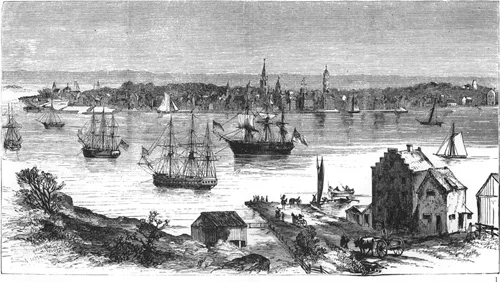
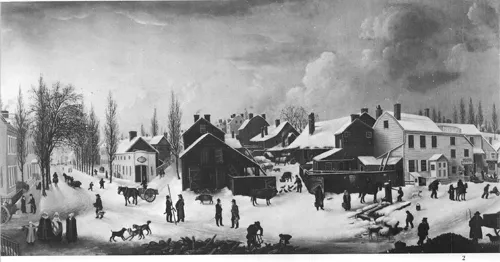

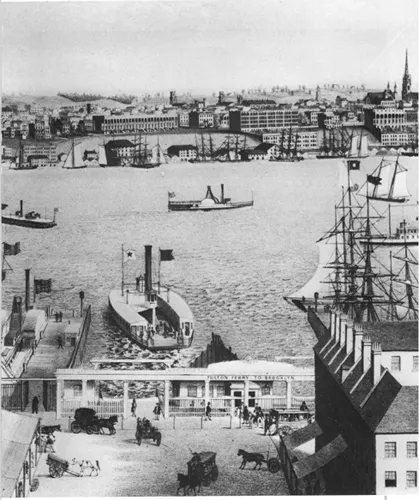

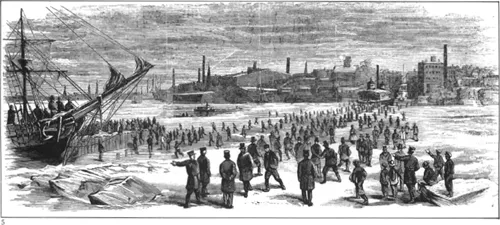
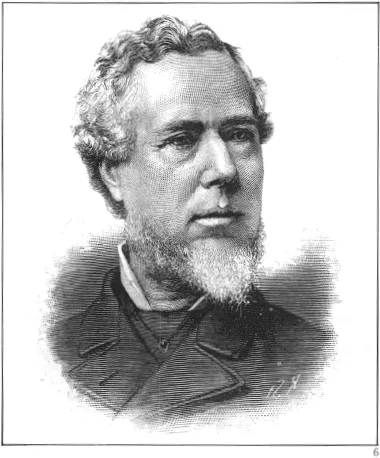

4. Thomas Pope’s Rainbow Bridge, 1811. Talk of a bridge connecting Brooklyn and New York had started as early as 1800, when Jeremiah Johnson (mayor of Brooklyn from 1837 to 1840) entered in his diary that such a bridge would “find more weight in the practicality of the scheme than at first view imagined.” He knew of a man who could build a bridge in two years’ time. That man may have been Thomas Pope, who in 1811 published A Treatise on Bridge Architecture. Pope wrote that he had devised a special method of building a wooden cantilever bridge which could span great distances. He designed his bridge for the Hudson River, proposing a 1,800′ wooden structure which would soar 223′ above high water. (The Brooklyn Bridge is 135′ above high water.) The drawing of his “flying pendent lever bridge,” although impractical and untried, was, at that time, a beautiful and daring vision, like “a rainbow rising on the shore.” Pope accompanied his treatise throughout with heroic couplets, which he composed himself, an example of which appears under this engraving:
Let the Broad Arch the spacious Hudson stride,
And span Columbias Rivers far more wide,
Convince the World America begins,
To foster Arts the ancient work of Kings.
And span Columbias Rivers far more wide,
Convince the World America begins,
To foster Arts the ancient work of Kings.
5. Ice bridge over the East River, 1867. The winter of 1866–67 was particularly severe; for weeks the East River was clogged with great chunks of ice which kept the ferries from running. As Harper’s Monthly remarked, there were passengers who could travel from New York to Albany and “arrive earlier than those who set out the same morning from their breakfast tables in Brooklyn for their desks in New York.” It was during this period that public agitation for a bridge began to be heard, making it possible for a handful of Brooklyn businessmen to create a coalition of various interests in order to get the project underway. This illustration shows a continuous sheet of ice which was formed shore to shore on January 23, 1867. On this occasion, thousands of people attempted to cross the river on foot—a very hazardous undertaking, since the ice immediately broke up when the tide turned, leaving many stranded on floating chunks of ice. However, few fatalities were reported, thanks to the rescue efforts of a variety of vessels, tugboats and ferries. 6. William C. Kingsley (1833–1885). A Brooklyn contractor, Kingsley had been promoting the idea of a bridge since 1865 when, at 32, he employed an engineer, and fellow Brooklyner, Col. Julius Adams, to draw up a design with cost estimates for material and labor. Kingsley was very active in Brooklyn politics and had worked on several important public-works projects, including Prospect Park and the Hempstead Reservoir. His company, Kingsley & Keeney Contractors, had made him worth close to a million dollars. 7. Henry Cruse Murphy (1810–1882). State Senator Henry Cruse Murphy, a respected Brooklyn lawyer who had been mayor of Brooklyn and was later American Minister to The Hague under President Buchanan, became interested in the bridge project after a meeting with Kingsley, who convinced him of the urgency of having a bill passed in Albany chartering the New York Bridge Company. Murphy drafted the incorporating charter and submitted it to the state legislature on January 25, 1867. It passed on April 16, but it would be another two years before actual work on the bridge was started. Murphy spent a major part of his adult life as president of the New York Bridge Company, from 1867 until his death in 1882. Like Moses, he led Brooklyn to the promised land and yet was denied the satisfaction of ever entering himself. Six months before the Brooklyn Bridge was officially opened, Murphy died at the age of 72, after successfully guiding the project through a bureaucratic labyrinth of political snarls and squabbles.

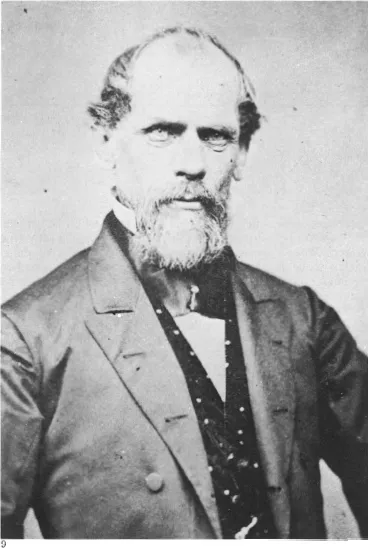
8. Bridge designed by Julius Adams, 1865. An early drawing of Adams’ design for a bridge, done for Kingsley, was published in the Union, a Brooklyn newspaper, on February 8,1866. The accompanying article stated that the bridge would run from a point near the head of Main Street in Brooklyn to Catherine Street between Madison and Henry Streets in New York, would be 4,250′ long with a central span of 1,350′ and would cost approximately $3 million. The Union worried about the feasibility of the plan and was especially concerned about the difficulty of fixing guy wires to stabilize the bridge. Noting that no such guys are shown in the design, the paper comments trustingly: “He has probably left them out as involving too much intricacy of detail in the drawing and not necessary to the comprehension of his plan. Without guys … the bridge would be blown away by the first breeze strong enough to drive a ship.” Henry Murphy took a drawing of Adams’ bridge to Albany with him and passed out copies to fellow legislators to drum up support for the project. Adams’ price tag was an especially attractive, albeit unrealistic, feature. 9. John Augustus Roebling (1806–1869). Born in Muhlhausen, Germany, Roebling had studied engineering at the prestigious Royal Polytechnic Institute in Berlin, where he received his degree in civil engineering in 1826. Here he also studied philosophy under Hegel, who, it is said, considered Roebling his favorite student. Roebling was undoubtedly a genius with an extraordinary sense of purpose and resolve who acted on Hegel’s belief that America “was the land of desire for all those who are weary of the historical lumber room of old Europe.” As Roebling himself wrote in his diary, “It is not contempt for our Fatherland that causes us to leave it … it was an inclination and an ardent desire that our circumstances may be bettered.” This photo was made shortly before Roebling died at the age of 63. 10–12. Pages from John A. Roebling’s Notebooks on Bridge Bu...